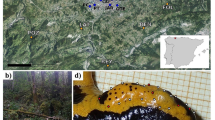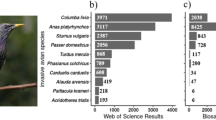Abstract
The trade-off between clutch and offspring size, which is a central topic in life-history research, is shaped by natural selection to maximize the number of surviving offspring, but it also depends on the resources available for reproduction. Conspecific populations living in different environments may differ in adult body size, clutch mass, clutch size, offspring size, and/or post-natal growth rates, due either to phenotypic plasticity or to local adaptation. Here, we compare these traits and their relationships between two populations of the lizard Psammodromus algirus separated by a 600-m altitudinal gradient. We used a common garden design to control incubation temperature and food availability, with two different feeding treatments. Females were larger at the high-elevation site. Although SVL-adjusted clutch mass did not differ between populations, high-elevation females laid more but smaller eggs than low-elevation ones. Hatchlings were larger at lower elevation. Our common garden experiment revealed that low-elevation hatchlings grew faster than high-elevation hatchlings under both feeding treatments. However, higher food availability at higher altitude allows high-elevation lizards to grow faster and attain larger adult sizes, especially in the case of females. The two key adaptations of low-elevation lizards, large eggs and hatchlings and the ability to grow rapidly after hatching, are likely to enhance survival in low-productivity Mediterranean lowlands. Our data support the hypothesis that the reproductive strategies of these populations provide an example of countergradient variation, because the genotypes that encode for fast growth and large body size occurred in low food availability habitats where juveniles grew slowly and attained small adult sizes.


Similar content being viewed by others
References
Adolph SC, Porter WP (1993) Temperature, activity and lizard life histories. Am Nat 142:273–295
Angilletta MJ Jr, Niewiarowski PH, Dunham AE, Leaché AD, Porter WP (2004a) Bergmann’s clines in ectotherms: illustrating a life-history perspective with sceloporine lizards. Am Nat 164:E168–E183
Angilletta MJ Jr, Steury TD, Sears MW (2004b) Temperature, growth rate, and body size in ectotherms: fitting pieces of a life-history puzzle. Integr Comp Biol 44:498–509. doi:10.1093/icb/44.6.498
Angilletta MJ Jr, Oufiero CE, Leaché AD (2006) Direct and indirect effects of environmental temperature on the evolution of reproductive strategies: an information-theoretic approach. Am Nat 168:E123–E135. doi:10.1086/507880
Arnett AE, Gotelli NJ (1999) Geographic variation in life-history traits of the ant lion, Myrmeleon immaculatus: evolutionary implications of Bergmann’s rule. Evolution 53:1180–1188. doi:10.2307/2640821
Arnold EN (1987) Resource partition among lacertid lizards in southern Europe. J Zool B 1:739–782
Ballinger RE (1977) Reproductive strategies: food availability as a source of proximal variation in a lizard. Ecology 58:628–635. doi:10.2307/1939012
Ballinger RE (1983) Life-history variations. In: Huey RB, Pianka ER, Schoener TW (eds) Lizard ecology: studies of a model organism. Harvard University Press, Cambridge, pp 241–260
Berven KA (1982a) The genetic basis of altitudinal variation in the wood frog Rana sylvatica I. An experimental analysis of life-history traits. Evolution 36:962–983. doi:10.2307/2408075
Berven KA (1982b) The genetic basis of altitudinal variation in the wood frog Rana sylvatica II. An experimental analysis of larval development. Oecologia 52:360–369. doi:10.1007/BF00367960
Berven KA, Gill DE (1983) Interpreting geographic variation in life-history traits. Am Zool 23:85
Blanckenhorn WU (1991) Life-history differences in adjacent water strider populations-phenotypic plasticity or heritable responses to stream temperature. Evolution 45:1520–1525. doi:10.2307/2409899
Boyce MS (1979) Seasonality and patterns of natural selection for life histories. Am Nat 114:569–583. doi:10.1086/283503
Braña F (1996) Sexual dimorphism in lacertid lizards: male head increase vs. female Sexual dimorphism abdomen increase? Oikos 75:511–523. doi:10.2307/3545893
Caley MJ, Schwarzkopf L (2004) Complex growth rate evolution in a latitudinally widespread species. Evolution 58:862–869
Chown SL, Klok CJ (2003) Altitudinal body size clines: latitudinal effects associated with changing seasonality. Ecography 26:445–455. doi:10.1034/j.1600-0587.2003.03479.x
Civantos E, Forsman A (2000) Determinants of survival in juvenile Psammodromus algirus lizards. Oecologia 124:64–72. doi:10.1007/s004420050025
Conover DO, Schultz ET (1995) Phenotypic similarity and the evolutionary significance of countergradient variation. Trends Ecol Evol 10:248–252. doi:10.1016/S0169-5347(00)89081-3
Conover DO, Duffy TA, Hice LA (2009) The covariance between genetic and environmental influences across ecological gradients: reassessing the evolutionary significance of countergradient and cogradient variation. Ann NY Acad Sci 1168:100–129. doi:10.1111/j.1749-6632.2009.04575.x
Cox RM, Skelly SL, John-Alder HB (2003) A comparative test of adaptive hypotheses for sexual size dimorphism in lizards. Evolution 57:1653–1669. doi:10.1554/02-227
Díaz JA (1997) Ecological correlates of the thermal quality of an ectotherm’s habitat: a comparison between two temperate lizard populations. Funct Ecol 11:79–89. doi:10.1046/j.1365-2435.1997.00058.x
Díaz JA, Cabezas-Díaz S (2004) Seasonal variation in the contribution of different behavioural mechanisms to lizard thermoregulation. Funct Ecol 11:867–875
Díaz JA, Carrascal LM (1991) Regional distribution of a Mediterranean lizard: influence of habitat cues and prey abundance. J Biogeogr 18:291–297. doi:10.2307/2845399
Díaz JA, Pérez-Tris J, Tellería JL, Carbonell R, Santos T (2005) Reproductive investment of a lacertid lizard in fragmented habitat. Conserv Biol 19:1578–1585. doi:10.1111/j.1523-1739.2005.00197.x
Díaz JA, Bauwens D, Asensio B (1996) A comparative study of the relation between heating rates and ambient temperatures in lacertid lizards. Physiol Zool 69:1359–1383
Díaz JA, Pérez-Tris J, Bauwens D, Pérez-Aranda D, Carbonell R, Santos T, Tellería JL (2007) Reproductive performance of a lacertid lizard at the core and the periphery of the species’ range. Biol J Linn Soc 92:87–96. doi:10.1111/j.1095-8312.2007.00877.x
Ferguson GW, Talent LG (1993) Life-history traits of the lizard Sceloporus undulatus from two populations raised in a common laboratory environment. Oecologia 93:88–94
Ficetola GF, De Bernardi F (2005) Supplementation or in situ conservation? Evidence of local adaptation in the Italian agile frog Rana latastei and consequences for the management of populations. Anim Conserv 8:33–40. doi:10.1017/S1367943004001805
Ficetola GF, De Bernardi F (2006) Tradeoff between larval development rate and postmetamorphic traits in the frog Rana latastei. Evol Biol 20:143–158. doi:10.1007/s10682-005-5508-6
Fitch HS (1970) Reproductive cycles of lizards and snakes. University of Kansas Museum of Natural History, Kansas
Grant BW, Dunham AE (1990) Elevational covariation in environmental constraints and life histories of the desert lizard Sceloporus merriami. Ecology 71:1765–1776. doi:10.2307/1937584
Hewitt GM (1999) Post-glacial re-colonization of European biota. Biol J Linn Soc 68:87–112. doi:10.1111/j.1095-8312.1999.tb01160.x
Iraeta P, Monasterio C, Salvador A, Díaz JA (2006) Mediterranean hatchling lizards grow faster at higher altitude: a reciprocal transplant experiment. Funct Ecol 20:865–872. doi:10.1111/j.1365-2435.2006.01162.x
Iraeta P, Salvador A, Díaz JA (2008) A reciprocal transplant study of activity, body size and winter survivorship in juvenile lizards from two sites at different altitude. Ecoscience 15:298–304. doi:10.2980/15-3-3119
Iraeta P, Monasterio C, Salvador A, Díaz JA (2011) Sexual dimorphism and interpopulation differences in lizard hind limb length: locomotor performance or chemical signalling? Biol J Linn Soc 104:318–329. doi:10.1111/j.1095-8312.2011.01739.x
Jin YT, Liu NF (2007) Altitudinal variation in reproductive strategy of the toad-headed lizard, Phrynocephalus vlangalii in North Tibet Plateau (Qinghai). Amphib Reptil 28:509–515. doi:10.1163/156853807782152507
Jin YT, Liu NF, Li JL (2007) Elevational variation in body size of Phrynocephalus vlangalii in the North Qinghai-Xizang (Tibetan) Plateau. Belg J Zool 137:197–202
Jonassen TM, Imsland AK, Fitzgerald R, Bonga SW, Ham EV, Naevdal G, Stefansson MO, Stefansson SO (2000) Geographic variation in growth and food conversion efficiency of juvenile Atlantic halibut related to latitude. J Fish Biol 56:279–294. doi:10.1006/jfbi.1999.1159
Lack D (1947) The significance of clutch-size. Ibis 89:302–352. doi:10.1111/j.1474-919X.1947.tb04155.x
Levins R (1968) Evolution in Changing Environments. Princeton University Press, Princeton
Levins R (1969) Thermal acclimation and heat resistance in Drosophila species. Am Nat 103:483–499. doi:10.1086/282616
Lorenzon P, Clobert J, Massot M (2001) The contribution of phenotypic plasticity to adaptation in Lacerta vivipara. Evolution 55:392–404. doi:10.1554/0014-3820(2001)055[0392:TCOPPT]2.0.CO2
Mathies T, Andrews RM (1995) Thermal and reproductive biology of high and low-elevation populations of the lizard Sceloporus scalaris: implications for the evolution of viviparity. Oecologia 104:101–111. doi:10.1007/BF00365568
Merilä J, Laurila A, Laugen AT, Rasanen K, Pahkala M (2000) Plasticity in age and size at metamorphosis in Rana temporaria—comparison of high and low latitude populations. Ecography 23:457–465. doi:10.1034/j.1600-0587.2000.230408.x
Nahal I (1981) The Mediterranean climate from a biological viewpoint. In: di Castri F, Goodall DW, Specht RL (eds) Mediterranean-type shrublands. Elsevier, Amsterdam, pp 63–86
Niewiarowski PH (2001) Energy budgets, growth rates, and thermal constraints: toward an integrative approach to the study of life-history variation. Am Nat 157:421–433. doi:10.1086/319321
Olsson M, Shine R (1997) The seasonal timing of oviposition in sand lizards (Lacerta agilis): why early clutches are better. J Evol Biol 10:369–381. doi:10.1046/j.1420-9101.1997.10030369.x
Olsson M, Shine R, Wapstra E, Uivari B, Madsen T (2002) Sexual dimorphism in lizard body shape: the roles of sexual selection and fecundity selection. Evolution 56:1538–1542. doi:10.1554/0014-3820(2002)056[1538:SDILBS]2.0.CO;2
Pincheira-Donoso D, Tregenza T (2011) Fecundity selection and the evolution of reproductive output and sex-specific body size in the Liolaemus lizard adaptive radiation. Evol Biol 38:197–207. doi:10.1007/s11692-011-9118-7
Pincheira-Donoso D, Hodgson DJ, Tregenza T (2008) The evolution of body size under environmental gradients in ectotherms: why should Bergmann’s rule apply to lizards? BMC Evol Biol 8:68. doi:10.1186/1471-2148-8-68
Roff DA (1992) The evolution of life histories: theory and analysis. Chapman and Hall, New York
Rohr DH (1997) Demographic and life-history variation in two proximate populations of a viviparous skink separated by a steep altitudinal gradient. J Anim Ecol 66:567–578. doi:10.2307/5950
Santos T, Pérez-Tris J, Carbonell R, Tellería JL, Díaz JA (2009) Monitoring the performance of wild-born and introduced lizards in a fragmented landscape: implications for ex situ conservation programmes. Biol Conserv 142:2923–2930. doi:10.1016/j.biocon.2009.07.017
Searle SR, Casella G, Mccullock CE (1992) Variance components. Wiley, New York
Sears MW (2005) Geographic variation in the life history of the sagebrush lizard: the role of thermal constraints on activity. Oecologia 143:25–36. doi:10.1007/s00442-004-1767-0
Sears MW, Angilletta MJ Jr (2003) Life-history variation in the sagebrush lizard: phenotypic plasticity or local adaptation? Ecology 84:1624–1634
Sears MW, Angilletta MJ Jr (2004) Body size clines in Sceloporus lizards: proximate mechanisms and demographic constraints. Integr Comp Biol 44:401–402. doi:10.1093/icb/44.6.433
Sinervo B (1990) The evolution of maternal investment in lizards: an experimental and comparative analysis of egg size and its effects on offspring performance. Evolution 44:279–294. doi:10.2307/2409407
Stearns SC (1976) Life-history tactics: a review of the ideas. Q Rev Biol 51:3–47. doi:10.1086/409052
Stearns SC (1992) The evolution of life histories. Oxford University Press, Oxford
Veiga JP, Salvador A (2001) Individual consistency in emergence date, a trait affecting mating success in the lizard Psammodromus algirus. Herpetologica 57:99–104
Verdú-Ricoy J, Carranza S, Salvador A, Busack SD, Díaz JA (2010) Phylogeography of Psammodromus algirus (Lacertidae) revisited: systematic implications. Amphib Reptil 31:576–582. doi:10.1163/017353710X521555
Via S, Lande R (1985) Genotype–environment interaction and the evolution of phenotypic plasticity. Evolution 39:505–522. doi:10.2307/2408649
Acknowledgments
This paper is a contribution to the projects CGL2007-60277/BOS and CGL2010-17928/BOS funded by the Spanish Ministry of Education and Science, and to the International Campus of Excellence (CEI Campus Moncloa) launched by Complutense University of Madrid (UCM) and Spanish Research Council (CSIC). P.I. was funded by a PhD. studentship from the Universidad Complutense de Madrid. Permissions to capture lizards were provided by the “Patrimonio Nacional” (owner of El Pardo) and the “Dirección General del Medio Natural” of the Madrid region. We thank Lin Schwarzkopf and an anonymous reviewer for useful comments on a previous version.
Author information
Authors and Affiliations
Corresponding author
Additional information
Communicated by Lin Schwarzkopf.
Rights and permissions
About this article
Cite this article
Iraeta, P., Salvador, A. & Díaz, J.A. Life-history traits of two Mediterranean lizard populations: a possible example of countergradient covariation. Oecologia 172, 167–176 (2013). https://doi.org/10.1007/s00442-012-2492-8
Received:
Accepted:
Published:
Issue Date:
DOI: https://doi.org/10.1007/s00442-012-2492-8




